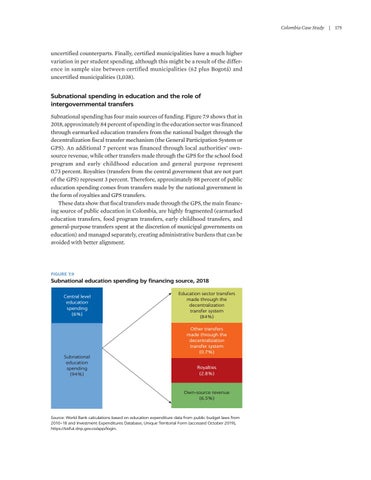Colombia Case Study | 175
uncertified counterparts. Finally, certified municipalities have a much higher variation in per student spending, although this might be a result of the difference in sample size between certified municipalities (62 plus Bogotá) and uncertified municipalities (1,038).
Subnational spending in education and the role of intergovernmental transfers Subnational spending has four main sources of funding. Figure 7.9 shows that in 2018, approximately 84 percent of spending in the education sector was financed through earmarked education transfers from the national budget through the decentralization fiscal transfer mechanism (the General Participation System or GPS). An additional 7 percent was financed through local authorities’ ownsource revenue, while other transfers made through the GPS for the school food program and early childhood education and general purpose represent 0.73 percent. Royalties (transfers from the central government that are not part of the GPS) represent 3 percent. Therefore, approximately 88 percent of public education spending comes from transfers made by the national government in the form of royalties and GPS transfers. These data show that fiscal transfers made through the GPS, the main financing source of public education in Colombia, are highly fragmented (earmarked education transfers, food program transfers, early childhood transfers, and general-purpose transfers spent at the discretion of municipal governments on education) and managed separately, creating administrative burdens that can be avoided with better alignment.
FIGURE 7.9
Subnational education spending by financing source, 2018 Central level education spending (6%)
Subnational education spending (94%)
Education sector transfers made through the decentralization transfer system (84%) Other transfers made through the decentralization transfer system (0.7%) Royalties (2.8%)
Own-source revenue (6.5%)
Source: World Bank calculations based on education expenditure data from public budget laws from 2010–18 and Investment Expenditures Database, Unique Territorial Form (accessed October 2019), https://sisfut.dnp.gov.co/app/login.






